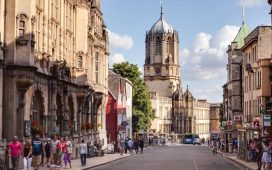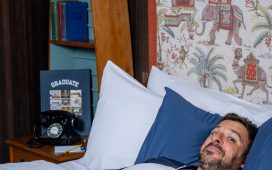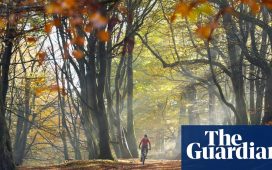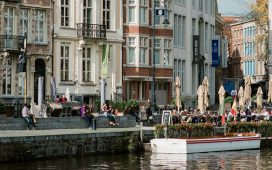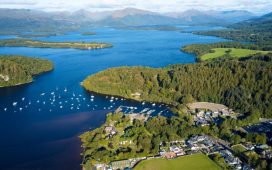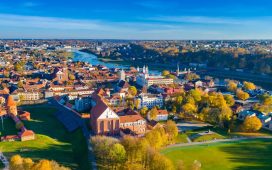I first learned about the Écrins national park in relation to a specific nature reserve within it. The réserve intégrale du Lauvitel was established in 1995 to “monitor the natural dynamics of ecosystems” with all human influence removed. This so-called wilderness area was one of the first of its kind in Europe.
A video showed an ecologist rowing across a dazzling, teal-hued lake surrounded by pine-strewn peaks. I was immediately fascinated. Admittedly, a forbidden zone taps into plenty of childhood adventure fantasies, but it’s also a bold statutory move a world apart from our more modest environmental experiments in the UK. Yet fortress conservation begs difficult questions: are humans a part of nature, or apart from it?
There was no way to set foot in the forbidden zone, but there was a way to get close. The Grand Tour des Écrins (GR54) is one of Europe’s finest long-distance trails, running through one of France’s largest national parks, which celebrated its 50th anniversary in 2023. Second only to Grand Randonnée 20 on Corsica in terms of difficulty, the GR54 is far less popular and busy.
More than 112 miles (180km) long and taking around 12 days, it circumnavigates the Hautes-Alpes, weaving through meadows and ancient mixed woodland, across wind-strafed cols andd beneath sunstruck seracs. On the way, there are more than 12,000 metres of cliffs, moraines, screes and schists to be walked, scrambled and stumbled up.
The Tour des Écrins is a real adventure – far from easy, yet still manageable for mere mortals. We begin east of Le Bourg-d’Oisans, south-east of Grenoble. On day one, we climb 1,000 metres up wooded switchbacks to a series of medieval hamlets hanging from the cliffs, each with its own water fountain, pausing to eat windblown plums and to smile at our new reality. Our first afternoon sees a hot march through ski infrastructure, but that’s the first and last of it. While the Écrins is not a backwater, neither has it succumbed to the commercialism of the central Alps.
Orchards and allotments are ripe and full. Cattle graze in open pasture on the margins of the villages. We’d expected a high alpine walk, so the ubiquity and variety of woodland between cols and settlements is a surprise. Huge stands of aspen shimmer on the hillsides, and alder, sycamore, beech, pine and birch line the rivers. Forest cover in France is at least double that of the UK, and unlike our own, the majority is broadleaf. The GR54 has adopted paths that have linked settlements for centuries, and to travel through these venerable glades adds real cadence to our journey – likewise, the sleepy village pitstops every day or three that offer good coffee or a génépi liqueur, fresh bread and fruit.
-
(Clockwise from top) dusky evening light above the Village of La Grave, Tour des Écrins signage in the south of the park, and a cross at the Col Saint-George, with La Meije behind
The Tour des Écrins is more than just a challenging walking holiday; it’s a chance to reflect on scale and proportion, on how to live better alongside nature. Early on, the vast grassland of the Emparis plateau gives us a closer look at the first of the high mountains, and seasonal grazing at altitude. I’m reminded of both Mongolia and the Lake District. Do we value all transhumance cultures equally, or are some lost altogether to industrial capitalism? Could we do things differently?
Beyond the protected Lauvitel reserve, park access is tiered, with grazing, fires, pets and pushbikes prohibited in some areas. It’s a compromise that seems to have allowed wildlife to find sanctuary. Ibex have been successfully reintroduced, while otters, beavers and bearded vultures are returning. Invertebrates and wildflowers thrive. Dragonflies as big as a hand, countless lizards and blinged-out beetles in red, green and blue jackets keep us company as we walk. Beyond the treeline, eagles coast the thermals, eyeballed by wary marmots, and powder-blue butterflies feed on the minerals supplied by glacier-fed, aquamarine headwaters. Abundance is the tonic you don’t know you’re missing until you witness it first-hand.
We don’t see or hear them, but wolves are also present, evidenced by temporary electric fences, the odd shepherd and their patou working dogs in the hanging valleys. The two I speak to are philosophical about the balance to be struck. Aline Robert clearly relishes the connection born from watching over several hundred sheep in the mountains. Justine Carpentier recalls losing 150 of her flock to wolf attacks, but says: “The wolf is not good or bad – it’s just like the weather. Like rain, we don’t always like it, but we need it, and we must learn to live with it.” As she points out, the relationship is not frictionless, but the French government gives grants for training and equipment, as well as compensation for losses.
Slowly, my friend and I circle the Écrins massif clockwise. In the south, the character of the walk changes and the mountains close in and surround us, each valley more beautiful and primeval than the last. From Vallouise, we bushwhack a forgotten path to a mill buried in the forest, cross a glacial riverbed and hike through a berry-decked canyon before climbing into a layer cake of shattered, oxidised metamorphic rock. Early the following day, we reach the moon-like high point of our journey, the Col de l’Aup Martin.
West of here the land is wilder still. Villages and the chance for resupply fall away along with the path, which often disintegrates under our feet. By day nine, my stinking shirt and I are no longer on speaking terms, but there’s ample compensation in the dreamlike state that comes with constantly moving on our own terms and under our own steam. We bivouac in quiet places to the sound of cicadas or an owl, the wind and the water – always water. Aches and pains recede; there is only beauty. In the final days, the heatwave breaks, and suddenly it is autumn, all swirling cloud on the cols, rain and falling leaves in the valleys.
We reach Lac du Lauvitel on our final day. The shore swarms with hundreds of visitors, while electrical pylons slice through the exclusion zone. The reserve does provide a control for important climate and biodiversity data, but it’s a dissonant experience. We clamber past the extensive ruins of a summer settlement and descend an ancient staircase to the valley floor, limping into Le Bourg-d’Oisans some hours later for beer, a shower and pizza.
The Tour des Écrins is the hike of a lifetime. It’s also a window into another approach to nature conservation. It’s all too easy to assume pastoral harmony when one is only passing through, but at the very least, the Écrins shows there’s more than one way to look after our wild places.
Where to stay
David stayed at the homely Bo Lodge (from €103) and the grand Hotel de Milan (from €112) in Le Bourg-d’Oisans, and in Le Vallois (from €94) in Vallouise. He used campsites and bivouacked (temporary camping high in the mountains) for the remaining days. It is possible to use refuges and hotels for the entire route but they need to be booked in advance, making for a strict itinerary.
How to go
For backpackers, it’s possible to resupply en route every two to four days. There are shops at Le Bourg-d’Oisans, La Grave, Le Monêtier-les-Bains, Vallouise and La Chapelle-en-Valgaudémar, but they may operate seasonal closing. Meals and drinks (generally of spectacular quality) can also be bought from refuges and villages en route: this is an essential part of the experience.
When to go
The high cols are generally passable between late June and early October. July and August are hot. June has the best flowers, and September has calmer weather.
David Lintern is a photographer and writer based in the Scottish Highlands

